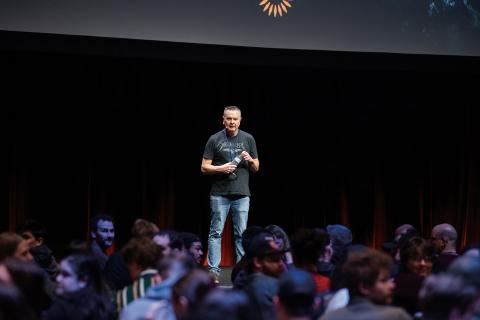Story by Rob Gerth
Image Courtesy Joe Paluska
Joe Paluska ’91 MBA fights for fusion for clean energy.
Climate warrior. That’s how Joe Paluska ’91 MBA, chief marketing officer at Commonwealth Fusion Systems, describes himself on his LinkedIn profile. “I caught the bug for both startups and for climate tech about 15 years ago,” says Paluska. “That’s when I met a founder-entrepreneur, who had a bold idea about how to end the world’s addiction to oil through a combination of renewable energy and electric mobility.”
He says he never looked back. “I just couldn’t go back because every day I asked myself, how can I look my kids in the eyes without trying to solve the world’s largest problem?”
Fusion figured out?
Paluska’s been at Commonwealth Fusion Systems just over a year. CFS spun out of MIT’s Plasma Science and Fusion Center in 2018. Paluska says it is the world’s largest fusion startup. He adds that there have been about 40 startups in this space in the past five or six years, with $6 billion invested in those companies (and CFS raised $2 billion of that $6 billion.)
“Fusion energy has always been viewed as the holy grail for carbon-free energy,” explains Paluska. “Governments and research universities have been working on it since the 1950s.” He says the company’s co-founders figured out how to engineer a process to make it affordable. (See the side bar for a detailed description of the fusion process.)
Electrification of everything
Paluska explains that part of his job is to help the company in what he calls “mainstreaming fusion.” “The inside joke within the fusion community is that fusion is always 30 years away,” he laughs. “We’re going to turn our machine on in about two years from now and prove to the world that commercial fusion is possible.”
Paluska notes that with the “electrification of everything,” including the number and size of data centers AI feeds on, and all the companies promising to go carbon-neutral, fusion energy is more critical than ever. Fusion will be cost competitive with renewables, oil and natural gas.
From MBA to streetfighter
“My Lehigh MBA helped me get my first four jobs,” says Paluska. “The mere fact of having an MBA got people’s attention. It gave me a little bit of a competitive advantage.”
Paluska claims his MBA turned him into a streetfighter. Currently, there’s an excellent Lehigh community in Silicon Valley. He goes to all the networking events, but that was not always the case. “If you went to Wharton or HBS or Stanford GSB, those were ready-made, instant communities,” he explains. “I felt that because Lehigh was lesser known, I had to be more of a streetfighter, a networker, to find my way. I’ve never lost it. I’m still a networker.”
Fusion Energy Science Explained
Image by Shutterstock/Art_of_Sun
Fusion Energy Science is a multi-disciplinary field focused on the science needed to develop an energy source based on controlled fusion. Fusion occurs when two nuclei combine to form a new nucleus. This process occurs in our Sun and other stars. Creating conditions for fusion on Earth involves generating and sustaining a plasma. Plasmas are gases that are so hot that electrons are freed from atomic nuclei. Researchers use electric and magnetic fields to control the resulting collection of ions and electrons because they have electrical charges. At sufficiently high temperatures, ions can overcome repulsive electrostatic forces and fuse together. This process—fusion—releases energy. —Department of Energy website



